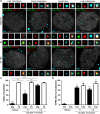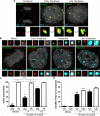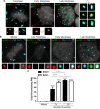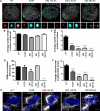PML nuclear body-residing proteins sequentially associate with HPV genome after infectious nuclear delivery
- PMID: 30802273
- PMCID: PMC6405170
- DOI: 10.1371/journal.ppat.1007590
PML nuclear body-residing proteins sequentially associate with HPV genome after infectious nuclear delivery
Abstract
Subnuclear promyelocytic leukemia (PML) nuclear bodies (NBs) are targeted by many DNA viruses after nuclear delivery. PML protein is essential for formation of PML NBs. Sp100 and Small Ubiquitin-Like Modifier (SUMO) are also permanently residing within PML NBs. Often, large DNA viruses disassemble and reorganize PML NBs to counteract their intrinsic antiviral activity and support establishment of infection. However, human papillomavirus (HPV) requires PML protein to retain incoming viral DNA in the nucleus for subsequent efficient transcription. In contrast, Sp100 was identified as a restriction factor for HPV. These findings suggested that PML NBs are important regulators of early stages of the HPV life cycle. Nuclear delivery of incoming HPV DNA requires mitosis. Viral particles are retained within membrane-bound transport vesicles throughout mitosis. The viral genome is released from transport vesicles by an unknown mechanism several hours after nuclear envelope reformation. The minor capsid protein L2 mediates intracellular transport by becoming transmembranous in the endocytic compartment. Herein, we tested our hypothesis that PML protein is recruited to incoming viral genome prior to egress from transport vesicles. High-resolution microscopy revealed that PML protein, SUMO-1, and Sp100 are recruited to incoming viral genomes, rather than viral genomes being targeted to preformed PML NBs. Differential immunofluorescent staining suggested that PML protein and SUMO-1 associated with transport vesicles containing viral particles prior to egress, implying that recruitment is likely mediated by L2 protein. In contrast, Sp100 recruitment to HPV-harboring PML NBs occurred after release of viral genomes from transport vesicles. The delayed recruitment of Sp100 is specific for HPV-associated PML NBs. These data suggest that the virus continuously resides within a protective environment until the transport vesicle breaks down in late G1 phase and imply that HPV might modulate PML NB assembly to achieve establishment of infection and the shift to viral maintenance.
Conflict of interest statement
The authors have declared that no competing interests exist.
Figures









Similar articles
-
An Adenovirus DNA Replication Factor, but Not Incoming Genome Complexes, Targets PML Nuclear Bodies.J Virol. 2015 Nov 25;90(3):1657-67. doi: 10.1128/JVI.02545-15. Print 2016 Feb 1. J Virol. 2015. PMID: 26608315 Free PMC article.
-
Incoming human papillomavirus 16 genome is lost in PML protein-deficient HaCaT keratinocytes.Cell Microbiol. 2017 May;19(5):10.1111/cmi.12708. doi: 10.1111/cmi.12708. Epub 2017 Jan 23. Cell Microbiol. 2017. PMID: 27860076 Free PMC article.
-
Promyelocytic leukemia nuclear bodies provide a scaffold for human polyomavirus JC replication and are disrupted after development of viral inclusions in progressive multifocal leukoencephalopathy.J Neuropathol Exp Neurol. 2008 Apr;67(4):299-308. doi: 10.1097/NEN.0b013e31816a1dd3. J Neuropathol Exp Neurol. 2008. PMID: 18379438
-
The Role of Promyelocytic Leukemia Nuclear Bodies During HPV Infection.Front Cell Infect Microbiol. 2020 Feb 19;10:35. doi: 10.3389/fcimb.2020.00035. eCollection 2020. Front Cell Infect Microbiol. 2020. PMID: 32154186 Free PMC article. Review.
-
PML and PML nuclear bodies: implications in antiviral defence.Biochimie. 2007 Jun-Jul;89(6-7):819-30. doi: 10.1016/j.biochi.2007.01.004. Epub 2007 Jan 27. Biochimie. 2007. PMID: 17343971 Review.
Cited by
-
HPV16 Entry into Epithelial Cells: Running a Gauntlet.Viruses. 2021 Dec 8;13(12):2460. doi: 10.3390/v13122460. Viruses. 2021. PMID: 34960729 Free PMC article. Review.
-
The COPII Transport Complex Participates in HPV16 Infection.Viruses. 2025 Apr 25;17(5):616. doi: 10.3390/v17050616. Viruses. 2025. PMID: 40431628 Free PMC article.
-
HPV16 Induces Formation of Virus-p62-PML Hybrid Bodies to Enable Infection.Viruses. 2022 Jul 5;14(7):1478. doi: 10.3390/v14071478. Viruses. 2022. PMID: 35891458 Free PMC article.
-
Persistent Human Papillomavirus Infection.Viruses. 2021 Feb 20;13(2):321. doi: 10.3390/v13020321. Viruses. 2021. PMID: 33672465 Free PMC article. Review.
-
Recent Advances in Our Understanding of the Infectious Entry Pathway of Human Papillomavirus Type 16.Microorganisms. 2021 Oct 1;9(10):2076. doi: 10.3390/microorganisms9102076. Microorganisms. 2021. PMID: 34683397 Free PMC article. Review.
References
-
- Zhong S, Müller S, Ronchetti S, Freemont PS, Dejean A, Pandolfi PP. Role of SUMO-1-modified PML in nuclear body formation. Blood. 2000;95(9):2748–52. . - PubMed
Publication types
MeSH terms
Substances
Grants and funding
LinkOut - more resources
Full Text Sources
Research Materials
Miscellaneous

